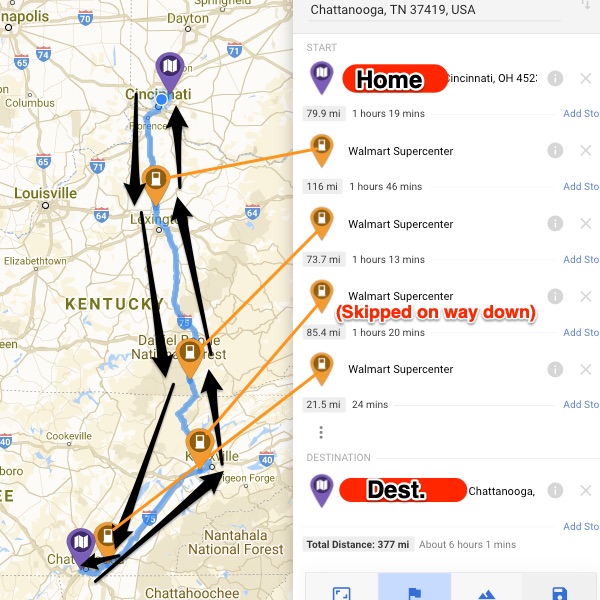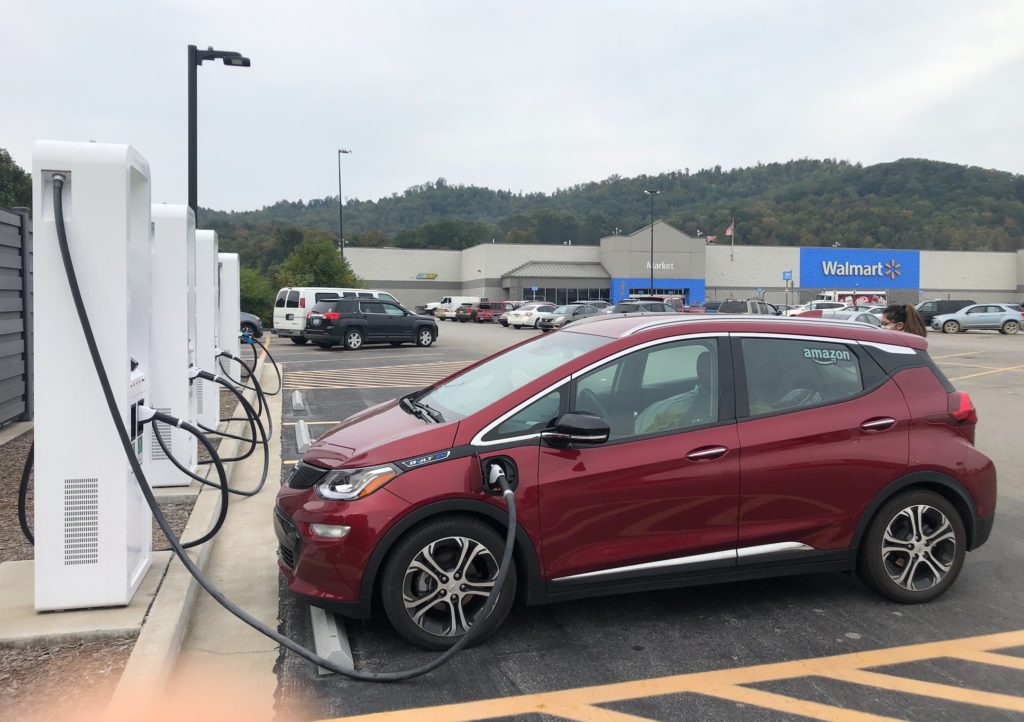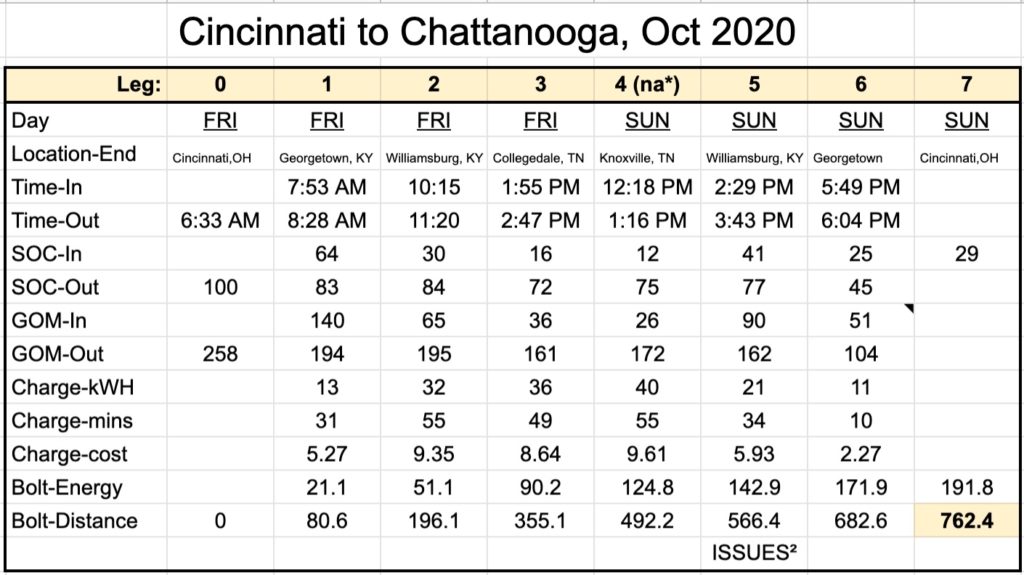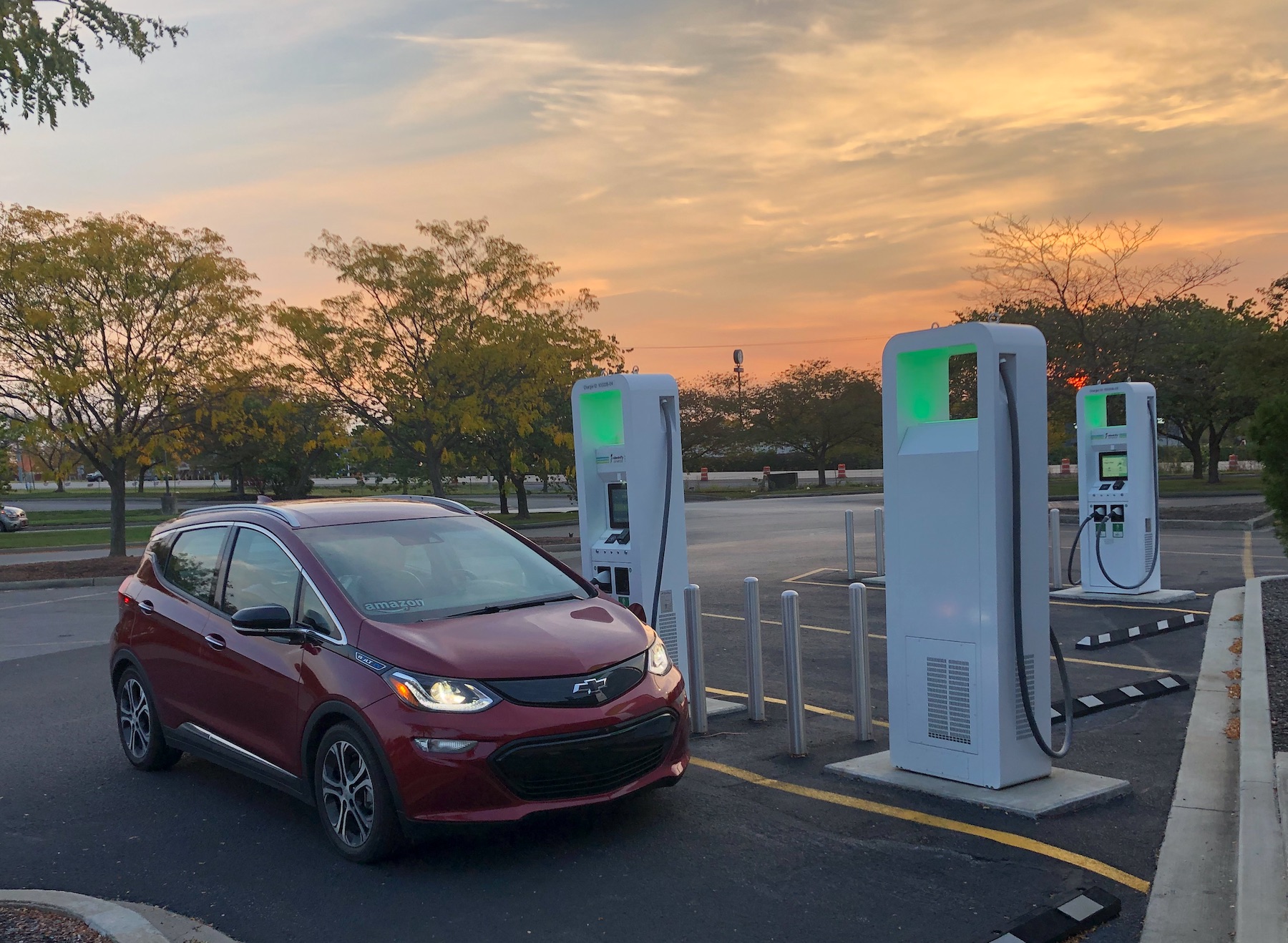Bottom Line
My overnight 760-mile road trip confirms that neither my Chevy Bolt nor the CCS charging network is well suited for this journey. Very sad for me to report this, but it is what it is. On the flip side, I am super excited that this trip is even possible and that I own an EV that can make the trip at all.
Trip Overview

In October 2020, I drove from Cincinnati, OH to Chattanooga, TN, and back. The one-way distance is ~380 miles. This a drive straight down I-75 and mostly in the beautiful rolling hills of Kentucky and Tennessee. My car is a 2017 Chevy Bolt EV with a max charging power of 50KW on the CCS standard, which is really the slowest DC “Fastcharging” there is (not very fast). I had done my research and knew that it was HIGH POSSIBLE that I’d run into some charging issues.
The route did not have many charging location options for me. Knowing that at this time, CCS charging is VERY OFTEN problematic, I went ahead and planned to stop every ~100miles even though my car could easily do more than that. It worked out that Electrify America was the only option. It seems they have partnered with Walmart and each of my stops was at a Walmart Superstore.
On the trip down, I decided to skip charging in Knoxville, TN because I had plenty of range (195mi) and knew I could easily make the Chattanooga charger at 159 miles. Also, I knew that there were many more charging options in Chattanooga (and my sister would be nearby to bail me out) if I ran into trouble at the planned charging station.
On the return trip, I skipped charging in Chattanooga because again I had plenty of projected range (161mi) to reach the next station (137mi).
By the Numbers
Here are some of the high level numeric results of this trip.
- Total time in transit: 17.6 hours – Of this time, 12.6 hours was driving and a FULL 5.0 HOURS was spent at the chargers. Yes, we tried to make good use of this time, but it shows how much this slows down travel.
- Fuel Cost: $54.38 – Charging on the road is extremely expensive! Not only is this 2.4 times the cost I would have paid at my home charger, but it is also 40% more than what I would have paid for gas if I had driven my Prius.
- Charging Power: 31kW – Although my car and all the chargers are rated for 50kW, the net effective charge rate was much less. Part of this is because I did charge beyond the 80% SOC (state-of-charge), but also sometimes the chargers would just slow down. This dramatically adds to the time needed to wait at the chargers. It takes the charging MPH (miles of range per hour) from an expected max of 180 MPH down to like 115 MPH.
The Good and the Bad
As I mentioned above, I only used Electrify America chargers which were all located at Walmart Superstores. It was very convenient for using the bathroom and shopping at Walmart, but in most instances it would have been a small walk to get to other fast food restaurants.

As for the chargers, the touchscreen was not working on the first station I used. This did not prevent me from using it though. The BIG HEADACHE was on the return trip, when the same charger (Williamsburg, KY) that worked fine on the way down, would not connect. This was a critical stopping point as there were NO OTHER fast charging options! After many attempts and working with support for over HALF AN HOUR, I was able to charge. Very luckily, the rain held off during this time, or I would have been SUPER TILTED!
It is great that my Chevy Bolt has an EPA range of 238 miles. But as other EV owners know, there are lots of considerations to keep in mind. First, when on the road, you are not going to want to charge past 80%. To keep the battery healthy, the charging rate dramatically slows after 80%. This drops of usable range to 191 miles. Next, there are not chargers at every exit. So you have to plan out where you are going to stop. Not good to run out of juice! One possible saving grace is that if you slow down, the efficiency and thus the range greatly increases. In my normal city driving which is still about half on the interstate, my efficiency goes up about 20% (3.76 for this trip to 4.7 miles/KWH)!
I made this trip during moderate Fall weather. Had it been hot or cold and I need to do more heating or cooling to keep the car comfortable, the range could have taken another SERIOUS HIT.
Electrify America

I am so glad that the Electrify America stations have been built. My understanding is that the money came from the Volkswagen “DieselGate” settlement. They look very nice and are well situated in the Walmart parking lots. In the 5 hours I spent at these stations during my 6 stops, I did not see any other EVs charging. And actually, I had comments from 2 different shoppers saying they had never seen anyone use the stations.
I will say that the Electrify America support people were very nice. It was somewhat reassuring to be able to easily talk to a real person. Although, it is disappointing that they could not determine my issue. It seems that the charging of non-Telsa vehicles is VERY PROBLEMATIC at this time.
Some Additional Geek Data
Here are a few other numbers I was able to crank out of this trip.

- Projected battery size: 61.9 KWH – You can do a calculation based on the delivered energy and the reported SOC (state-of-charge) before and after charging to project your battery size. Battery KWH = KWH delivered / (SOC2 – SOC1).
- Car efficiency: 3.76 mi/KWH – When driving around Cincinnati, I generally average well over 4.5 mi/KWH. For this trip, I was driving at posted speeds (when possible) and you can see how much it really drops the efficiency. The Chevy Bolt is known for having a very efficient drivetrain, but it is not very aerodynamic so the efficiency really drops at higher speeds.
- Speed impact of charging: -18.6MPH – My average driving speed was 60.5 MPH (vast majority was I-75, generally the posted speed was 65 or 70, some construction zones). If you factor in the time charging, my net speed drops to a pedestrian 41.9 MPH.
- GOM Error: +/- 5% – The GOM, Guess-O-Meter, is what EV people call the cars remaining range indicator. It guesses at the range based on your previous driving habits. For the first leg, the GOM range was 17% too high, but this was expected. Later in the trip, it seemed to be within 5% of the actual range I was able to achieve.
Conclusion
In the end, the trip ended up pretty much as expected. I was hoping for ZERO charging issues, but not that surprised when it did happen. It really slowed my trip down, but also made it somewhat easier. I enjoy getting out and walking so I did not really mind the downtime. The next time I do this trip, I’ll problem take my Prius though. The Chevy Bolt with the 50 KW max charging really does eat up a lot of time.
I expect and hope that the charging networks continue to expand and become more reliable. For this car, a larger and more reliable charging network will not significantly change the trip dynamics. It just is not designed to charge quickly. It is possible that I will try an even longer trip in my Chevy Bolt once we get the pandemic under control, but in the meanwhile, I’ll just enjoy my local emission-free (yes, I charge at home off renewable energy) driving.
